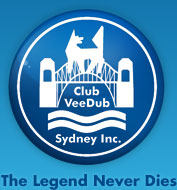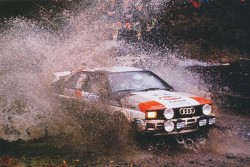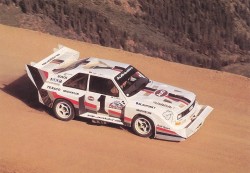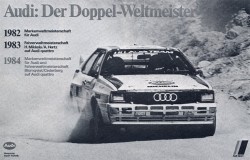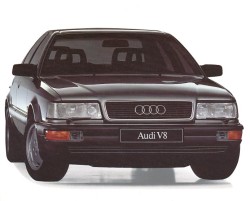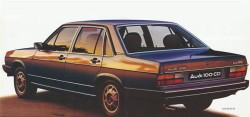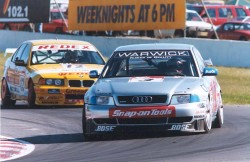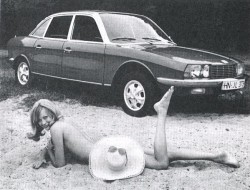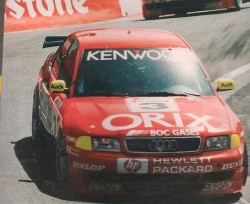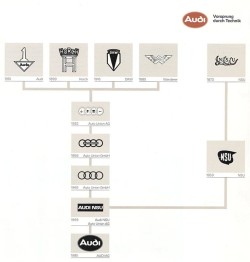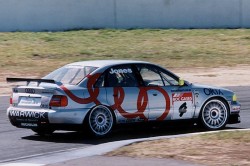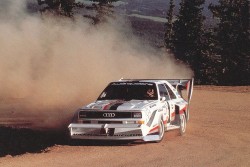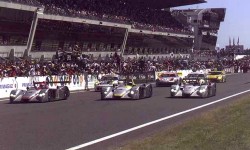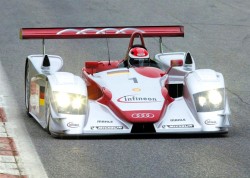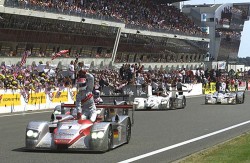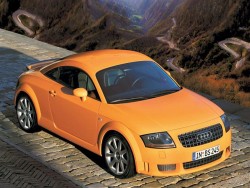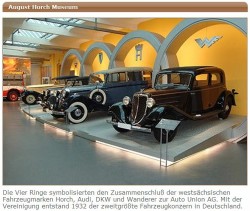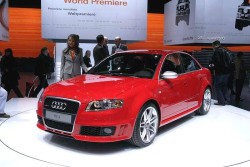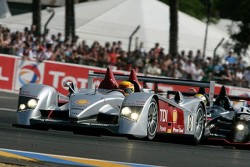Audis
The Audi quattro
Pikes Peak Paralogism
Ur-quattro Beginnings
The More Things Change
My Next-door Neighbour’s Audi (and Mine)
Audi Wins its First Australian Motorsport Title
NSU Ro80
A Fast Lap Around Bathurst
Audi Historical Highlights
Jones Makes History for Audi
Peugeots are better than Audis
Audi wins Le Mans 2000
Audi repeats Le Mans win 2001
Audi achieves Le Mans hat trick
Audi TT 3.2
The August Horch Museum
Audi RS4 supercar
Audi Diesel wins Le Mans
The Audi quattro
By Jeff Whitten
June 1992
The original or ‘Ur’ Audi quattro (note the lower case ‘q’) has been withdrawn from sale after a decade of production and more than 11,000 units. Make no mistake, the quattro will be sadly missed. Every rally fan will have memories of the quattro whether it be photos in a magazine, the glorious sight and sound on a Club video or even a rare memory of the car itself, its 5 cylinder engine belting out its familiar spine-tingling howl. However, thanks to LNC Industries not importing it, the quattro was an unknown vehicle in Australia and its history may be somewhat of a mystery.
Germany’s finest-ever rally car was introduced to the world when a number of other manufacturers were about to release new 2-wheel-drive rally cars onto the international scene. The quattro's arrival set these manufacturers back on their heels, and to pen a cliche, quickly sent them back to their drawing boards.
Revealed to the world at the Geneva Motor Show in March 1980 and campaigned in world rally events from 1981, Audi’s 4-wheel-drive, 5-cylinder turbocharged wonder wasn't the first production vehicle in the world to employ 4WD for its passenger vehicles, but it immediately became the most successful. Few of the opposition could match its awesome traction advantage from its new fangled transmission system, especially on gravel.
So successful was the quattro’s early career that it won the second world championship event that it entered. By the end of the first season Hannu Mikkola, the new Audi Team driver, had won the most demanding event in Europe, the Lombard RAC Rally, and from that moment on the quattro was on a roll.
The combination of new technology, 4WD, an enormously powerful 5-cylinder turbocharged engine, and the driving skill of Hannu Mikkola, took the inexperienced Audi team to the top of the ladder in an indecently short time.
For a while, most observers thought that the quattro’s supremacy was partly due to its superior straight-line performance. However, road tests of the day showed that the big, heavy Audi was no faster than the current Opel and Ford rally cars. Its winning ability was simply due to the uncanny knack of putting power to the ground with minimal wheel spin. Its superiority was all about traction and roadholding. True, it was not unbeatable on tarmac, where a well-driven Ford Escort or an Opel Mantra could see it off on most occasions. But on events like the Swedish, 1000 Lakes, the Monte Carlo and so many other loose surface rallies, the quattro was the yardstick by which the others had to measure themselves.
Suddenly rear-drive was no longer good enough. ‘4WD’ and ‘turbocharging’ were the in-words of the 1980s. But as well as changing the face of rallying, many of today's top drivers cut their teeth in a quattro. Drivers like Hannu Mikkola, Stiq Blomqvist, Walter Röhrl, Michelle Mouton, Malcolm Wilson and numerous others all piloted the quattro. While Franz Wittman was the first driver to win an event in the quattro, Mikkola was the one to put the Audi name well and truly on the map.
Mikkola was brought to Audi in 1980 as the road car was nearing its pre-release development phase. The Finn was suitably impressed with the car, and agreed to drive it the following season.
To say he set the rallying world on its ear by taking an 11-minute win on the 1981 RAC Rally would be an understatement. Such a large winning margin was unheard of, but became more astonishing considering a mid-event roll that cost him valuable time. Yet he still led home drivers like Ari Vatanen, Stiq Blomqvist and Pentti Airikkala.
The Audi was making a habit of establishing ‘firsts’ in rallying, for it was in that first season that the delightful and very talented Michele Mouton made history by taking the car to victory in a round of the Manufacturers Championship, the first lady ever to win a round of the World series.
It didn't all go Audi's way in that first year of competition. While wins in the Swedish, RAC and San Remo rallies were highlights; the rest of the season was fairly unremarkable. The quattros were disqualified in Greece for fitting a supplementary battery in the cockpits, and Mikkola, Mouton and Wittman were thrown out of the event.
But better was still to come, and 1982 brought more dramatic achievements. The high-tech German car had shown it could outgun anything the opposition could throw at it, so they began frantically redesigning 4WD machinery under the new Group B rules, which had just come into effect.
Stiq Blomqvist had secured a works drive with Audi, and celebrated this with wins on the 1982 Swedish and San Remo. Michele Mouton won the Portugese, Acropolis and Rally of Brazil, and Mikkola dominated the 1000 Lakes and the RAC. For good measure, quattros were also second on the 1000 Lakes, the RAC and San Remo as well. Hannu Mikkola became the most successful rally driver of all time, while Audi won the Manufacturers World Rally Championship, the first German company ever to do so.
Hannu Mikkola and Arne Hertz won the Drivers World Rally Championship in 1983, along with second place for Audi, behind Lancia, in the Manufacturers Championship. Audi won thirteen national championships with the quattro that year. The new Audi Sport quattro was glimpsed for the first time at the 1983 Frankfurt Show in September.
Winning both the Manufacturers and Drivers World Championships had always been Audi's goal, and they had won the first in 82 and the latter in 83. In 1984 they would win both! This was due to two factors; one being that Walter Röhrl had joined the team as a driver, and the other was the debut of the Group B Audi Sport quattro.
Walter Röhrl was a sensation in the Sport quattro, and the German team swept all before them that year. While the older long A2 quattro was good, the Sport quattro was unbelievable. Its wheelbase was 320 mm shorter than the earlier model, and the 5-cylinder, twenty-valve turbo engine produced 450 bhp, compared to 360 bhp in the A2 model.
For a while in 1984 the Audis steamrollered on - until Peugeot unveiled their 205 T16; the era of the Group B supercars had begun. When Ari Vatanen brought his 205 home well clear of 4th placed Blomqvist in the 1000 Lakes, it seemed the quattro’s dream run might well have ended. With an equally powerful engine and 4WD to match, the Peugeot showed a clean pair of heals to the Audi. While the 205 had a mid mounted engine and near perfect balance, the quattro suffered from a big, heavy engine sitting forward of the front axle, causing excessive understeer.
But despite its faults, the development that had gone into the Sport quattro still rendered it more than a match for the new Peugeots. The Sport quattro made its debut on that year's Ivory Coast rally, and in the hands of Blomqvist won with relative ease. Mikkola was placed second, and the results achieved were sufficient to net Stiq and his navigator Bjorn Cederberg the Drivers Championship and the Makes title for Audi. But that was the last tune the quattros had it all their own way.
1985 saw even more Group B madness unfold. Peugeot had the 205 T16, Lancia the powerful Delta S4 (often even faster than the Peugeot), Austin Rover had the Metro 6R4 and Ford showed their RS200. Audi retained their Sport quattros, this time in evolution S1 form with just over 500 bhp. Yet Audi had been surpassed by other makers, who went one better. For the S1 Sport quattro was still based on a road car, while the Peugeot, Lancia and Metro were far removed from production vehicles. Both the Makers and Drivers titles were won by Peugeot and Timo Salonen, but Walter Röhrl took the San Remo in the S1, his first and only win that year.
1986 saw the final, most powerful version of the quattro arrive. With the updated S1 Sport, there was no mistaking that it was a purpose-built rally car. Bedecked with huge wings, spoilers and other aerodynamic aids, the updated S1 was an enormously powerful beast. Horsepower jumped to over 600 bhp, coupled to a 6-speed semi-auto gearbox. However, the power outputs of the Peugeots and Lancias were about the same, and it took super drivers to handle these twitchy, brutish cars.
The writing was on the wall for Group B when fatal accidents started occurring at some events. When an RS200 Ford ploughed into a crowd of spectators in Portugal, killing three of them, the event was abruptly terminated when the leading manufacturers withdrew their cars on the spot. Audi withdrew its teams from the World Rally Championship, and ended their Group B participation for good.
The end of Group B racing itself came shortly afterwards, when the brilliant Henri Toivonen and his co driver Sergio Cresto were killed when their car speared off the road during the Tour de Corse.
And so the quattro era drew to a close, and with it one of the most exciting periods in rallying history. Anyone who has had the privilege of standing by the side of a special stage to watch a works quattro thunder by knows only too well the awesome sight they presented.
Australia was only fortunate enough to have one original quattro compete in this country. Queenslander Geoff Key's example was a familiar sight in a number of events around the country until its untimely end in a fire last year.
Now all reminders of the quattro era have gone, with production ending last year in Germany.
Except for one thing. Any rally car worth its salt today has least two by-products of the Audi quattro era – four-wheel drive and turbocharging. And for that reason alone we can mourn the passing of the world's original and most spectacular supercar.
Pikes Peak Paralogism
By Phil Matthews
June 1992
One of the current TV ads for Peugeot shows off its sporting prestige by mentioning the result of the Pikes Peak hillclimb in 1988, when 405 16T driver Ari Vatanen won the event and set a record which still stands today. Quite true, but it doesn’t tell the story with anything like the correct balance.
Pikes Peak is a 4,301 m mountain in the Colorado Rocky Mountains, and is the scene for the most famous hillclimb event in the world. For teams and drivers alike, it demands endurance and speed over the 19.96 km gravel road, which includes 157 unguard-railed corners in the climb from 2,866 m up to the 4,301 m summit (Mt Kosciusko is only 2,230 m high.)
Hillclimbs have been held there since 1916, when Rea Lentz in a Romano Special won in a time of 20 minutes 55.6 seconds. VWs and their derivatives have competed since the 1960s, when classes were arranged for open wheelers, stock cars, and open and production rally cars. VW and Porsche-engined buggies, rails and Bajas have proved successful, particularly when turbocharged.
VW themselves attacked Pikes Peak from 1985 to 1987 with different twin-engined Golfs, the most extreme example having two 16V 1800cc turbo engines mounted longitudinally! Audi’s first attempt was also in 1985, when Michele Mouton blasted a Sport quattro to the top in a winning 11 minutes 25.39 seconds, a record then. How humiliating for the good ol’ boys in their big super stock Chevys and Dodges, to be beaten by an attractive woman with painted fingernails!
In 1986 Audi was back again, this time with Bobby Unser Sr. driving an improved Sport quattro. It’s hardly surprising that he won the event, but what is amazing was his time; 16 seconds quicker than Michele Mouton’s effort the previous year, with 11 minutes 9.22 seconds.
In 1987 things got serious. Peugeot appeared for the first time with specially-prepared rear-engined 205 turbo 16s, driven by ‘87 Paris-Dakar winner Ari Vatanen, five-time Safari rally winner Shekhar Mehta and Italian rallyist Andrea Zanussi. This was a souped-up version of the awesome Group B rally cars that had been outlawed the previous year. Other ex-Group B cars included an Austin-Rover M1 Metro 6R4, Ford RS 200s, 4WD Mazda RX7s as well as the usual open wheelers and super stock cars. Audi’s only entrant was a ‘batmobile’ S1 Sport quattro driven by world champion Audi works rally driver Walter Röhrl.
The winner? Although the Peugeot was fastest in practice, the event went to the amazing Walter Röhrl, who blasted the Audi to the top in an amazing 10:47.85, shattering Bobby Unser's record by 21.4 seconds! This was Walter Röhrl’s first ever attempt at Pikes Peak, and he beat Ari Vatanen’s Peugeot by more than 15 seconds. The best V8 open wheeler buggies were a further 20 seconds behind, with the ungainly super stockcars more than one and a half minutes off the pace.
Audi did not return to Pikes Peak in 1988, concentrating instead on the USA TransAm circuit-racing series (which they went on to win!) with the Audi 200 quattro. They had proved their point.
In Audis absence, Ari Vatanen did go on to win the 1988 Pikes Peak, the last time the event saw the awesome Group B rally cars, with a record time of 10:47.22 This is the basis of the Peugeot TV ad, and was also the basis of a spectacular short film called ‘Climb Dance'.
But on his second attempt, and with twelve months extra development under their belt, Ari Vatanen and Peugeot could only beat Walter Röhrl’s time by 0.63 seconds, over a distance of nearly 20 km! That’s only a 0.097% improvement. Compare that with the huge leaps by which Audi would improve each year.
And here’s some food for thought: After his 1987 record, Walter Röhrl admitted that he had made many mistakes (being his first attempt), and that should he try again he could shave a further 25 seconds off his time! What a shame that never came about.
Why is it that Audi, with a better rally competition history than Peugeot, are not promoted as such by the Australian importers TKM, who share both marques?
PS. The printed version of the Peugeot ad also states that should the car go over the edge, it will accelerate downwards at “32 feet / sec / sec.” This is beneath contempt. The acceleration of free fall (g) is scientifically recognised as 9.807 ms-2 (although it varies slightly with locale). The French, in particular, would be insulted at the use of medieval units to sell their cars!
Ur-quattro Beginnings
By Graham Robson
March 1993
In the mid-‘seventies, the West German military provoked the development of the precursor to the Audi Ur-quattro. Their requirements dictated a replacement for their ageing cross-country vehicle, the DKW Munga. The VW/Audi group successfully tendered to design and build such a vehicle, whose underpinnings became the basis of the Ur-quattro's success.
Ferdinand Piech (then Audi R&D Director) oversaw the project, which was to develop a vehicle called the Iltis. It received large orders from the West German and Dutch army. The Iltis was a conventional 4WD, but featured all-independent suspension and a long-stroke 1.7 litre version of the VW Passat/Audi 80 engine. The gearbox/transaxle was also derived from the Passat/80 front wheel drive cars, modified by way of an open propeller shaft to the rear axle. Shortly after the release of the Iltis at the Amsterdam Motor Show in 1979, a civilian version became available, with a peak power output of 53 kW and an unladen weight of 1,550 kg.
During the development of the Iltis, one of the senior Audi project managers, Walter Treser, secretly modified the Iltis four-wheel drive components to fit an Audi 80 sedan, without being given authority to do so. After his experience in racing and rallying, Treser was convinced that a performance-oriented road car would benefit greatly from four-wheel drive, and so used his own initiative by testing and improving on his secret project. By 1977 he was confident enough with his development to offer the Audi Chairman, Gottlieb Strobl, a drive of the vehicle. The Chairman was impressed, and the project was then officially approved.
As for Treser's motivation for conceiving a four-wheel drive road car, there was no thought at this point of using the vehicle in competition, simply because the Appendix J homologation regulations stipulated that only two-wheel drive was permissible. With some discreet lobbying by the Germans, the FIA (La Federation Internationale des Automobiles) changed this rule in 1979 by permitting the use of four-wheel drive. Thus the Audi quattro development team could include in their brief not only the development of a high-performance road car but also one that could be competitive in world-class rallying.
The basis of the quattro bodyshell was the Audi 80 platform, introduced in sedan form in 1978. The Audi coupe, a two-door fastback derived from the sedan, was due for release in September 1980. It was this body that the quattro development team used for their car. Subtle guard flares to accommodate wider wheels, and a tail skirt were the only visual differences. The floorpan was modified to accept the quattro drivetrain, and the front wishbones were reversed for the rear suspension, which also used the MacPherson struts from the front.
To be competitive in Appendix J rallying the quattro would need more power than the rally favourites, which were far lighter cars. The weighty quattro would need not only the five-cylinder engine released in 1976 in the 100, but turbocharging as well. The normally aspirated 2144cc 100 motor was good for not much more than 136 bhp. As the standard for competitive front runners in international rallies was around 250-270 bhp, this motor as it was, was not good enough. However by installing a KKK turbocharger and intercooler, with Bosch or Pierburg fuel injection, the rally version of the five-cylinder turbo could develop 320-330 bhp at 6500 rpm.
The quattro was not a car designed in isolation. The body was a close derivative of the Audi Coupe. The motor and gearbox were derived from the 200 turbo. The rear suspension and subframe was from the front of the 200 and of course the four-wheel drive components from the Iltis. What made the quattro so special was how extraordinarily well it all came together. This car had the engine and suspension as good as any other sports coupe, but with one significant advantage - four-wheel drive transmission. With this came the discovery that the friction involved in powering two extra wheels was negligible - in fact the four-wheel drive cars proved slightly more economical than the two-wheel drive cars.
The traction the quattro provided meant that one had to get used to driving it. The press fleet cars suffered an unusually high accident rate, and in the first six months of quattro production demand was unusually high for replacement front spoilers and radiators. It was thought at the time that this was due to the unrivalled adhesion of the quattro, where journalists and even private owners were becoming overconfident. While perhaps a trap for the unwary, the quattro had achieved the ultimate in international rallying in 1984 - seven wins in ten world title events, Audi taking out the World Rally Championship of Makes, and Blomqvist and Cederberg winning the World Rally Driver’s Championship with their quattro.
The Audi quattro was not purely a convenient image-maker for Audi. The development work of Piech also provided for the use of the quattro drivetrain in other vehicles. Hence the Audi 90 quattro, the Coupe quattro and the 200 quattro were soon on sale, quickly attracting buyers particularly in inclement countries where four-wheel drive is a must. Before these Audis, the choice was limited strictly to Range-Rover type vehicles.
The More Things Change...
By Steve Carter
June 1993
They say there is nothing new under the sun, and the same can be applied to cars.
For example Hemi heads, which Chrysler made such a big noise about in the '70s on their Valiants. Hemi heads, or hemispherical combustion chambers, have been about since almost the dawn of the automotive age.
Also the G60 supercharger fitted to the VW Corrado, Passat III and Golf II is actually an old design, which previously was unable to be manufactured successfully - until VW worked out a method to accurately machine components to extremely high tolerances of fit.
So if you may or may not be aware that the new Audi V8 has a different style of front disc brake system; different that is, but not new. This system uses the same principle as used on the Maico after-market disc brake system for early Beetles.
For those of you whom are not familiar with either system, I will enlighten you. Imagine an LP record held between your thumb and fingers, and you have the conventional disc brake. The record is the disc, your hand is the calliper and your fingers the brake pads.
It is a system that works well, but with limitations. To increase braking power you need to increase the disc size for greater leverage or pad area, and that is where problems arise.
To increase disc size, remembering that the overall diameter of the disc and calliper is a great deal bigger than the disc alone, so you need larger diameter wheels; not always a feasible option. To increase the pad area would add to complexity, not to mention unsprung weight.
Now imagine a doughnut similar in outside diameter to the LP record, but with a much larger inside hole. Put your hand into the hole of the doughnut and grab the doughnut ‘disc’ from the inside. Put the LP record and and LP-sized doughnut side by side and you will immediately see that the latter, with its internal calliper, takes up far less space. Apply this principle to a real car with doughnut-shaped discs with internal callipers, and there can be a considerable increase in disc diameter (and remember the advantage of extra leverage), without the need to increase wheel diameter.
This brilliant old idea was jointly developed by Audi and brake manufacturer Alfred Teves for the new Audi V8 flagship. The V8 has ventilated discs front and rear.
Audi has for some time experimented with various brake systems, including angled discs in a bid to increase braking without resorting to over-size tyres and rims.
Audi engineers discovered that the brake area could be increased by 20% using this system, and under repeated fade tests it was found that the ‘doughnut’ discs had a 150 degree Celsius reduction in maximum temperature than the old style system. Another advantage is that because the calliper is mounted onto the stub axle closer to the wheel centre, the brakes have more feel and less power assistance is needed.
My Next-Door Neighbour's Audi (and Mine)
By Rod Young
September 1993
This month I’m reporting on a car belonging to my neighbour.
It would have been a shame to see such a nice car, a dark blue 1979 Audi 100 CD, dismantled in the name of spare parts, so it was snapped up for a price I'm not telling you. The car immediately won the approval of my neighbour’s six-year-old son, because it has little lights in the back doors that shine down onto the ashtrays. Also, the central locking almost nearly worked, which is not one of those things to be expected. So it got the thumbs up.
It had had a recent spray job and surprisingly little rust, and what there was of that is currently undergoing excision. Like with so many other 100s of its vintage, rust is bubbling up from around the scuttle panel; that’s the one around the base of the windscreen (if anyone knows why it's called a ‘scuttle’ please let me know. Probably nautical in origin). I think the clips that hold the chrome trim in, which themselves rust away, are the catalyst for these attacks. The windscreen is bonded in with urethane. Audi was the first European manufacturer to use this process, and it has some advantages, such as improving the overall body stiffness and eliminating a rusty floorpan due to water leaks from that area. Unfortunately, on my next-door neighbour's Audi, the rust goes too close to the windscreen to allow easy repair and the screen must be removed. The urethane gets very hard over the years and it did not want to give, so the screen, along with the removal tool, did not survive the removal process.
At least as much money as the car originally cost has been spent on it, since there are plans to make this car last. First it was the front end. The front tyres were scrubbing out; the car veered to the left under braking and mysterious noises emanated from the general strut area. The wheel alignment man advised not investing the $35 because it needed new bushes. Investigation showed that all the rubber bushes for the suspension subframe, control arms, sway bar and strut lop mountings were variously split, squashed or mutilated, so fairly serious replacement was in order. The genuine Audi parts were quite dear (31% of the value of a blue 1979 Audi 100), but made the world of difference after installation, expertly done by Adrian Muller. We've since found out that these parts are available in urethane from AP Spares in Riverstone, and Nolan in Thornleigh. Usually the gearbox mounts go the same way, apparently, but they were OK on this car.
Next on the agenda was to investigate why the compression was low in one cylinder and the idle so rough as to rattle your teeth. Tony, the amiable Austrian at AP Spares, pulled the head off and replaced five exhaust valves, amongst other things such as an exhaust manifold, welsh plugs and hoses. Tony will tell you any day of the week that Audi and VW water cooled engines are far superior to BMW engines, something he also knows a thing or two about. He found that someone in the past had rather inexpertly installed a high lift cam. After the head went back on, we couldn’t believe the performance of this car. 100s were never thought of as a quick car and were criticised as such by the motoring magazines at the time, but this thing fair rockets along.
Now that it s going more than half decently, it's a very rewarding car to drive. Smooth ride, effortless power, light controls, and great long distance cruising ability. The technology and appearance are still far from dated; it's easier to justify driving this car to your friends than, say, a 1979 Toyota Crown or Nissan 280C. People even compliment you on your nice car, and are genuinely intrigued when they fail to answer correctly the question about how many cylinders it has. And it doesn't take more than a week to get used to the massive steering wheel and sitting on a cushion, even with the seat height adjustment up to the max. One of these days I’ll get the central locking right.
I've always thought it would be great to own a series 3 Audi 100, even though that's not really what they're called, but you know the one - built 1983-1990, great aerodynamic shape, flush windows, 5-cylinder engine. Such cars were always for the better-off class of people, I thought; I would never be in the position of owning something so desirable.
My previous method of conveyance was as far removed from the luxury and comfort of this car as you could get - a 1973 Type 3 station wagon. It was always an unfinished project, with highly idiosyncratic modifications that I won’t go into. Nobody ever wanted to get into that car with me, and I don't blame them. It was ugly, noisy, uncarpeted and smelt bad. Ashamed as I was of the Type 3, it was always my intention to finish it one day. This was the cross I had to bear, I thought, but then the pressure of getting a pink slip for it when registration was already overdue after an overseas trip was too much, and the salvation of a seductive replacement in the form of an Audi 100 came along.
I had already been driving a borrowed, earlier model 100 and I appreciated its virtues. The prospective replacement belonged to well known club member Ed Garcia, and we all know how he looks after his cars. The price was right, thanks to depreciation through lack of appreciation of Audis on the Australian market.
So it was with some surprise and pleasure that I found myself owning this car. What a contrast to the foul Type 3!
The first thing I noticed, something I still notice every day with never ceasing amazement, is that the aerodynamics work. Lift off the throttle and it cruises along just as quickly. Where other cars are still on the throttle approaching a corner, I'm trying to slow this car down. Comparison is valid because I’m used to the previous model 100, which has the same basic engine, gearbox and suspension; all the differences are in the body.
I was plagued for a long while by a leaking power-steering pump. It wouldn’t have been so bad if it were ordinary ATK, but Audi sees fit to use their own purpose-designed fluid, and when it costs around $30 a litre, a leak is a serious proposition. The pump not only powers the steering but the brakes, which removes a bulky vacuum servo from the engine compartment.
I tried everything I knew to plug the leaks, which were coming from around some pressed-in plugs. Araldite; solder; peening with a centre punch. Eventually a replacement was found, oh joy, because I had gone through five bottles of the expensive stuff by that stage.
The only other thing to cause me ongoing angst is the climate control. According to the owners manual, it’s normally only fitted to the 200T, a much more expensive car. It must have been specified particularly for the Australian market. The unit is made by AC Delco in the USA. The designers have been too clever by half. Its sophistication sort of matches the space shuttle (you know what happened to that); three electronic units, numerous sensors and a mass of wiring. Apart from the fact that some parts of it don’t work, such as getting air to the dash-level vents, it just can’t know that I'm feeling warm or hot in the same way as I can. To operate it, you dial in a target temperature. The electronics supposedly warm up or cool down the interior until the desired temperature is reached, then maintain it. But driver and passenger have no control over which vents or fan speed. I've gone to the trouble of fitting a fan switch from a Golf and will soon install switches to control the air outlets. OK chaps, your next design needs to have remote temperature sensors embedded under the skin of the passengers, dealer installed. These transducers should measure skin galvanic response and transmit a signal to another control unit (no room behind the dash - try under the seat), which automatically opens a window.
As far as long-term longevity of this car is concerned, I'm optimistic. There isn’t one speck of rust on it, even though it isn't one of the fully galvanised models introduced in 1985. I’ll have to do something about the cracked dashboard: a sore point for VW/Audis. I’ll be changing to silicone brake fluid, renewing some front-end bushes and replacing the water cooled ATK cooler with an air cooled one, just in case, as they are known to fail, with horrendous results for the transmission.
By the way, I’ll soon be wrecking a Type 3.
Audi wins its first Australian Motorsport title
By Steve Carter
December 1996
Brad Jones and the ORIX Audi Sport Australia team have given the German car maker its first ever Australian motorsport title with a clean sweep in the 1996 BOC Gases Australian Super Touring Championship, winning the drivers’, manufacturers' and team prizes.
But it was no easy fight for the Albury-based team, with the battle for victory going right down to the last race at the last round at Oran Park over the weekend (Saturday 9 November 1996) with Jones having to win both races to take the drivers' title. Team mate and Bathurst winner, Greg Murphy, also had to finish both races to enable Audi to add the manufacturers' and team awards to its 1996 account.
The 1996 Super Touring season opened with two non-Championship events, the first in support of the Melbourne Grand Prix and the second at the Indycar Grand Prix at Surfers Paradise. Fresh out of the box, the ORIX Audi A4 quattros put in an impressive performance at the Melbourne Grand Prix, but not enough to overcome the Diet Coke BMW team.
Paul Morris and Geoff Brabham had received their new cars before the Adelaide Grand Prix, and an off season of testing under Australian conditions provided two convincing wins for BMW.
By the time the Super Touring circus arrived at Surfers Paradise, the ORIX Audi Sport Team had got some testing under its belt and was ready for a good performance at the circuit where it had its best performance in 1995. It was not to be, thanks to a combination of poor event organisation and a massive accident for Brad Jones that did more to prove the Audi A4 quattro’s inherent safety, if not its racing-winning ability.
So by the time the BOC Gases Australian Super Touring Championship opened its doors for the first time at Sydney's Amaroo Park in May, the ORIX Audi A4 quattro had shown a great deal of potential but it had yet to take the chequered flag in Australia. That all changed at Amaroo Park. Jones and Murphy dominated totally, with the red and blue ORIX Audi A4 quattros leaving everyone else in their wake for a walkover one-two victory.
But by the time the team arrived at Lakeside, the spectre of a weight penalty levied on the highly successful Audi teams abroad began to hang over the team. Jones and Murphy looked as if they were on the way to another dominant win when Jones’ engine decided it had had enough in race one and the race switched to the paddock, with the ORIX Audi Sport Australia team battling to repair the Audi A4 quattro in time for the next race. A new engine was slotted into place in just 53 minutes and its running-in period was flag to flag win for Jones.
The ORIX Audi Sport Australia team returned to Amaroo Park with an unwelcome guest in its cars, a 30 kg lead weight strapped to the body to bring the Audi's performance back in line with the other competitors. It didn't stop Jones winning both races. Murphy had his share of problems, though, with a new engine slotted into his car replaced a failed unit that kept him out of practice and which left him in fifth place in race one.
Greg Murphy's first win came at Mallala, following Jones leaving the track on another car's oil and narrowly missing Morris who was flying backwards. The talented New Zealander almost got his second win in race two: Brad Jones, who had led for the whole race, miscounted and slowed down a lap early for the finish. After seeing off an opportunist move by Geoff Brabham, Greg let Brad past metres before the finish. “The most embarrassing moment of my career,” Brad Jones called it!
Winton, the Albury-based team's home track, should have been a walkover for the team, but it turned into the worst event of the season. A combination of a new surface on the track and tyres that could not cope with it had Jones and Murphy sideways so often it was more like a rally. To compound this, Murphy went out in an accident in the race.
Phillip Island was better, but not much. Following a clockwork one-two in race one, Jones and Murphy were ready for a repeat in race two, until a puncture sent Jones into the pits. A second tyre failed, thanks to damaged bodywork, and Jones was out of the race. Murphy then drove to his second win but not without a lot of pain. The power steering failed in his car near the start and the battle to finish left him slumped over the wheel of his car shattered with exhaustion metres after talking the chequered flag.
Lakeside's second round, and the penultimate round of the series, saw BMW equipped with two brand new BMW 318i 1996 cars to Audi’s 1995 models, still with the 30 kg ballast. This gave the Diet Coke team a decisive advantage, giving Murphy two mid-field finishes, while Jones, who finished third in race one, and spending race two battling to recover from a start line accident with a resultant 12 minute driveshaft and rear suspension swap to keep him in the race.
So, far from going into the last round of the series at Oran Park in the totally dominant position predicted by the media at the start of the season, the organisers, TOCA, had ensured that the final round was a fitting nail biter for what has proven to a uniquely exciting race series.
Super Touring is now positioned, with its fourth Australian season in 1997, to provide motorsport fans with a level of competitive motorsport action that will keep them glued to their seats at the race track and in front of the TV.
NSU Ro80
By Tony Davis
June 1998
Car of the Decade. Machine of the Future. The most significant automobile since WWII. There seemed no praise too lavish for the stunning NSU Ro80, unveiled at the Frankfurt Auto Show in Germany in September 1967, and released for sale in Australia from mid-1969.
The front-drive, wedge-shaped exercise in advanced aerodynamics and improved packaging efficiency was truly revolutionary, and set the tone for the so-called aero cars of the 1980s.
Furthermore, the NSU newcomer was fitted with a Wankel rotary, the smooth, compact and powerful miracle of design that was poised to oust the standard reciprocating engine from its smug position of power.
The car received worldwide acclaim. Twelve international motoring journalists voted the Ro80 "1967 Car Of The Year", the first time a German model had captured the coveted award. The English magazine Car voted the Ro80 the "most significant technical development of the year".
Yes, the Ro80 was a once-in-a-generation car, changing all that followed. The pity was that it sent its manufacturer broke and left tens of thousands of owners enormously unhappy.
The Ro80's twin rotor engine had a capacity of only 995cc, yet developed a huge 96 kW. That was the good news. NSU had even developed the Ro80's engine further into the marine Ro135 derivation, developing 105 kW. 16 licence partners took out manufacturing agreements on the Wankel engine design, including Fichtel & Sachs, Toyo Kogyu (Mazda) and Yanmar, and these manufacturers between them sold an additional 33,600 rotary engines in 1969 alone. This brought NSU much licence income, though still not enough to pay for the enormous development costs.
The bad news went beyond the unfortunate decision to name the engine after its designer, Felix Wankel. NSU was in financial trouble and the Ro80 had been rushed to market before the engineer's considerable concerns about mechanical durability had been fully addressed.
In Australia the Ro80 caused great excitement; athough at $6,400 it was priced against Jaguars, Mercedes Benz, Rovers and BMWs. Sales were not especially brisk in the fairly conservative luxury market.
The Australian NSU importers (LNC Industries, who owned Volkswagen Australia), tried to counter Wankel anxiety with an extended warranty - which just added to the huge bills it faced. The engine seals were made of a soft iron alloy and failed to do the one thing they were supposed to, namely seal the chambers created by the triangular rotor within the epitrochoidal (oddly shaped) housing. Engine failure at 16,000km and less was common.
Around the world, NSU replaced thousands of engines free - alas, with more Ro80 engines. NSU refused to accept full responsibility for the engines' premature failure, as they apportioned much blame on poor maintenance and "abuse of the free-revving nature of the Wankel engine."
It was a particular shame because the Ro80 had so many other virtues. Consider the roomy cabin with long, flat floor, the clever clutchless semi-automatic transmission, the almost eerie quietness and smoothness, and the 175 km/h top speed.
In late 1969, the Volkswagenwerk took over the financially challenged (ie. bankrupt!) NSU company, and merged them with their Audi division. Ro80 production continued for another eight years, although Australian sales were wound up in mid-1973.
37,400 Ro80s were built at Audi/NSU/Auto Union's Neckarsulm plant by the time the model was finally wound up in September 1977, just after the one millionth Audi (since 1965) was completed. It was the last production vehicle to carry the famous NSU name.
Many former NSU engineers stayed on, and later helped to refine the Ro80 concept in a completely new design for Audi. The conventionally powered (but otherwise surprisingly similar) Audi 100CS of 1982 finally realised the promise of the brilliant but fatally flawed NSU Ro80.
A Fast Lap around Bathurst
By Brad Jones
September 1998
Bathurst is one of the most demanding circuits in Australia, and because we only really race here once a year, you only have one opportunity for success. This is what it is like to drive around the circuit in the current Audi A4 touring race car.
The fast lap begins at Pit Straight, which is slightly uphill. By the end of the straight you have reached 180 km/h and you are in fourth gear. You brake hard, go back to second and turn hard left into Hell Corner (now commonly, and boringly, called ‘Turn One’). This is one of the track’s most critical corners because of the long haul up Mountain Straight. A mistake here means you have to carry it all the way to Griffins Bend. If you are down 500 revs coming out of Hell Corner, you will still be down 500 revs when you get to Griffins Bend. Also known as GTX Bend, Griffins Bend at the top of Mountain Straight is a right-hander and requires precise braking.
Back to third gear and because the road has a slight off camber, you can float the car into the corner and get onto the accelerator early. It is important to keep plenty of speed on the car, as there is steep climb to the Cutting. You get up to 165 km/h on the way up to the Cutting, and it is a very hard brake - the road is quite rough and undulating.
Back to second gear, concrete walls on either side of you. You are about to start the steepest climb on Mount Panorama. The road kinks to the right, over a bump and you quickly move into third gear. Running along the fence, you grab fourth gear as you turn right and head into Reid Park. Reid Park is where you come over a rise and then down through a dip. This is one of the toughest parts of the circuit. You run parallel with the concrete wall that is about 15 cm away from you, before you turn left at 190 km/h.
A slight lift of the throttle, turning right, there is a large curve on the inside of Reid Park that you need to get as close as possible to, but making sure that you don't hit it! If you do happen to hit the curb on the inside of the corner, it will throw you onto the curb at the exit of the corner and cost you valuable time. Then there is a slight rise into McPhillamy Park. This is one of the most famous corners of this track. Taken at 180 km/h with a change into fifth gear midway around the corner. Fifth gear takes you across Skyline at 210 km/h. You then start the rapid decent down the mountain.
Coming into the Esses you are usually in the middle of the road because it has takes you that long to get back over there. The first turn is to the left and it is blind! You can't see it coming, you have to brake very hard and you need to stay on the right hand side of the circuit. This is the part of the track that the Audi really excels. It is usually flat on the throttle just before you get airborne in the Dipper. Brake to settle the car down and then back on the throttle.
On the run down the hill you hit the rev-limiter then turn right and the car is really light. Like the corner coming up the hill, Forrest's Elbow is critical, as you really have to carry the speed down the hill. You hug the apex, and then you let the car drift right out as far as you can.
Conrod Straight is a little bit rough and the car tends to bounce around. You check your gauges and get on the radio and have a drink.
Going through the Chase is flat, you then get on the brakes after the dip. The car drifts across the road nicely through the left hander. You are flat through the right-hander out of the Chase and over the brow. There is a chink in the white line and I use this as a brake marker.
Like the first turn, the final one is a late apex corner so you get a clean run up over the finish line.
Hope you enjoyed your ride!
Audi – Historical Highlights
By Steve Carter
February 1999
After several years' employment at Benz & Cie, August Horch left his job and founded his own firm, August Horch & Cie, on 14 November 1899. He began as a repairer of automobiles. Routinely he installed Bosch coil ignitions with a linkage developed and patented by Horch himself. In 1901 for the first time Horch built his own car and tested it. Now he could introduce the features he had tried in vain to recommend when he worked for Benz - e.g. a shock-free engine whose two cylinders share a common combustion chamber, and a transmission interlocked with the differential and suspended from the frame behind the rear axle.
The following years saw the realisation of more of Horch's extraordinarily innovative ideas: for example, a Cardan-shaft power transmission and chromium-nickel steel heavy-duty gear wheels. Another significant innovation is an engine with overhead intake valves.
In 1905 Gertrud Eisemann caused a sensation. One of the first and fastest of Germany's woman motorcyclists, she ranked in fame second to none of the men then competing on two wheels. Frau Eisemann sets several motorcycle records. Among her long-distance triumphs is first place in the Eisenach-Berlin-Eisenach race, won on an NSU 2-hp. The manufacturer of this machine, NSU of Neckarsulm, was compiling an outstanding record of competition success, and remained a major world exporter until the outbreak of the First World War.
August Horch quit his own company in 1909, and founded a new one called August Horch Automobilwerke GmbH in Zwickau. Due to clashes with his previous company, the new company’s name was soon changed to Audi - the Latin for ‘Horch’. The word ‘Horch’ also means ‘Hark!’ or ‘Listen!’
Here is August Horch on his experience with early motor cars: “To start the engine you had to set the flywheel spinning; there was no question of cranking up the motor in those days; you just kept turning the flywheel until ignition occurred. It was hard work, but exciting.
“If you couldn't get the motor to ignite you had to go to the front of the car and play with the 'mixture control lever'. If you were lucky and the motor ignited straight off, you still had to run to the front and adjust the throttle valve lever till the engine began running smoothly. Then and only then - God willing - you could begin to set the vehicle in motion.
“You would get into the driver's seat and the car would start to move at a speed of about three to five km per hour. When she had reached maybe eight km/h, you would release the smaller gear and engage the larger one. From that point you might nudge her up to, say, a maximum of 18 km/h.”
Horch's first trucks were built before the First World War. Their earliest commercial vehicle was an ambulance, and the first heavy-duty vehicle was a chaff cutter built on a passenger car undercarriage. Some 8/24 chassis were made into delivery vans; others, fitted with 40- or 50-hp motors, became small trucks or light omnibuses. Motors of a mere 55 hp were used to power 3-ton trailer trucks.
In 1913 Horch himself, behind the wheel of an Audi, received first prize in a tortuous 2,250 km race on mountain roads - hence the car's name, ‘Der Alpensieger’ (Victor of the Alps). A four-cylinder vehicle, the ‘Type C’ was to become the best-known Horch model. The 14/35-hp engine boasted a crankshaft of completely new design, positioned 14 mm off axis in triple-babbitted red brass bearings.
The Audi team had picked up prizes in 1912, 1913 and 1914. The sedate trade journal ‘Motorwagen’ waxed enthusiastic: “The outcome, above all, was an amazing triumph for the German manufacturer Audi. Of five automobiles entered in the contest they brought all five through the finish line without a single point deducted.”
Meanwhile, at another German car company called Wanderer, the compact ‘Puppchen’ is at last produced for the market. Gruelling tests revealed the beauty of this new Wanderer concept. The four-cylinder, 12-hp engine and delicate, light body respond perfectly to high demands for performance and economy. So satisfied is everyone with the ‘Puppchen’ that the firm politely declines the offer of another small car model, designed by one Ettore Bugatti!
The basic, ever popular ‘Puppchen’ continued to be manufactured for fourteen years, before being replaced by a higher-performance model. Some changes were introduced after the First World War, such as overhead suspension of the two valves, and engine capacity increased to 1.3 litres. Although the designation ‘5/15 hp’ was retained, actual maximum performance is now 20 hp.
The 1921 Audi Type K was the direct successor to the famous ‘Alpensieger’. With its now standard left-hand drive, it made its debut at the Berlin Automobile Exposition. No longer cast in pairs, the cylinders now formed part of a grey cast-iron-headed aluminium cylinder block; the combustion chambers were also re-designed. Each combustion chamber was fitted with diagonally aligned valves, operated via the camshaft at the side of the crankcase with push rods and rockers. No fewer than three oil pumps provided lubrication of the motor. Cooling was achieved without a water pump, by the thermo-siphon principle, utilising a multi-speed, four-blade fan.
Between 1921 and 1923 engineering innovations came thick and fast. Audi was the first with left-hand drive, and a steering wheel that could be folded back. The Audi K included a tachometer as a standard feature and a ‘reserve’ lever setting on the fuel tank cap. Other innovations were the first Babbitt bearing-mounted crankshaft in a six-cylinder car and the first use of a suspension damper. At this time Audi was also a pioneer in the filtering of inlet air. Another innovation at this time is fluid-friction brakes. In 1927 the eight-cylinder Audi R made its first appearance. With its 100-hp motor it was capable of smooth acceleration directly from 8 km/h to speeds of up to 110 km/h. The firm's commitment to technical progress on every level receives visual expression in the new streamlined design of the Audi Type K.
The Horch 303, one of the first series production cars with an 8-cylinder in-line engine, appeared on the market in 1926 and soon becomes a symbol of excellence in the German automobile industry. To keep down the length of the car, the cylinders were cast in pairs in the cylinder block, with coolant only flowing between the pairs. With a capacity of 3.0 litres, the engine yields 60 hp. A total of eight gearwheels, working together, operated valves, lubrication, generator and coolant pump. A special model, the Horch 375, had rear springs 145 cm long consisting of 18 layers of chromium vanadium steel. This was also the first time a Horch car was designed with hydraulic vibration absorbers.
DKW was the biggest manufacturer of motorcycles in the world by 1928. Expertly co-ordinated management and a sharp eye for talent ensured product popularity. Among the talents discovered and employed were those of Hugo Ruppe from Leipzig, who contributed the two-stroke engine; Friedrich Miinz of Stuttgart, who developed the Dynastart, a combination generator and starter; Dr Herbert Venediger, the first to study the two-stroke engine systematically; and Hermann Weber, the chief constructor at Zschopau, whose motorcycle designs were among the best on the market.
All attention was riveted on Horch's sports convertible, first shown at the Paris Automobile Salon in 1931. Under her yellow bonnet the car displayed a new wonder: a 12-cylinder, V-type engine with 6-litre capacity. To meet the highest demands in performance, the seven-bearing-mounted crankshaft was furnished with twelve balancing weights with a suspension damper at the front end. A special duct system provided for the lubrication of the pistons, and the valve lifters were hydraulically operated.
Also in 1931, DKW introduced the F1 at the Berlin Automobile Exposition. It was the prototype of the first mass-produced small car with a transverse engine, front-wheel drive, and independent wheel suspension. Its plywood chassis, covered in imitation-leather, took only six weeks to develop.
These four car makers joined up together in 1932. The four-ring symbol was adopted, representing the linking together of Wanderer, Horch, DKW, and Audi in the AUTO UNION in June 29th 1932. Soon it became Germany's second largest manufacturer of motor vehicles. The new trademark symbolised the unbreakable union formed by the four companies.
It took AUTO UNION about three years to co¬ordinate its various types, models and policies into a unified profile. The result appeared in the standardisation of chassis and undercarriage, and the common use of certain basic parts in construction. Economy was now a paramount consideration; the greatest pressure was for cost reduction. A more streamlined chassis, patented by Paul Jaray, was introduced. It underwent extensive testing in the wind tunnel.
This was how the motoring magazine ‘Automobiltechnische Zeitung’ reacted to some of the new models: “As the German AUTO UNION makes its debut in Paris, Horch dominates the entrance to the salon with three machines, all prize exhibits with distinctive bodies. One of them is a short, light-green sport convertible with a 4.5-litre engine; another is a Silberfisch convertible with a 5-litre engine; the third is a dark brown 12-cylinder limousine with double downdraught carburettor, intake silencer, overdrive synchromesh gear, compressed-air hydraulic power brake, fresh-air heating, illuminated map table, four-wheel jack, anti-theft installation, etc. What a lot of cunning, outrageous devices! This apparently extensive Horch product line proves you can turn out a broad range of products with economically limited - but cunningly deployed - means.”
Hans Stuck set a world record at the Avus in 1934 with the new AUTO UNION racer. The construction was by Dr Ferdinand Porsche. For the first time in a racing car, the engine (16 cylinders) was situated behind the driver, anticipating by several decades a principle of construction commonly observed today.
The first soundly based, empirical crash test programme (incidentally, satisfying modern criteria) was begun in Germany by the Central Test Department of AUTO UNION in Chemnitz in 1937. At the time DKW had introduced what was to be its last series of models, some of which had chassis constructed of synthetic materials. In such tests head-on and side-on collisions and rollover are simulated. Over 3,000 national and international patents attest to innovations introduced by the Saxony automakers, as a result of these experiments.
By 1939 AUTO UNION offered a vast array of motor vehicles, from motorcycles to luxury limousines. Germany's second largest automobile manufacturer now produced 25% of all private cars and 35% of all registered motorcycles.
As a major supplier of motor vehicles to State administration and the armed forces, AUTO UNION'S government contracts, by 1937-1938, exceeded the total production of all Audi, Horch, DKW and Wanderer private vehicles. Horch and Wanderer military vehicles were reliable workhorses for the German forces throughout the war, as were DKW and NSU motorcycles.
The AUTO UNION works were in the Eastern, Russian-controlled sector of Germany. After the war, pursuant to orders of the SMAD (Soviet Military Administration in Germany), the works in Chemnitz was dismantled and expropriated by the occupying power. Most of the machinery was shipped to the USSR. In 1948 the AUTO UNION name was struck from the Commercial Register. However, pre-war DKW designs were used by the Russians to produce the Trabant, which was built in the old Zwickau works until the 1990s.
In the West, to help cope with the post-war transport shortage, AUTO UNION was resurrected in Ingolstadt, Bavaria, in 1949 and began production on the F89L delivery van, the first post-war German vehicle with a forward control chassis. This DKW pick-up van was exhibited at the 1949 Spring Fair in Hannover. It had a two-stroke motor. By the end of the year a total of 504 F89L pick-ups and 500 DKW RT 125/W motorcycles had come out of the factory. The ‘W’ in the name stood for ‘West’, to distinguish these motorcycles from those of the same type built in Zschopau, in the Russian Zone.
The first new DKW passenger car, the F89P, rolled off the line at the company's new Dusseldorf plant in 1950. As in former times, this vehicle was presented under the title, ‘Meisterklasse’, a term which expressed the combination of pre-war chassis unit with the two-stroke motor (now boosted to 23 hp) (F8), and body (F9). This car was offered as a limousine, four-seater convertible (Karmann), two-seater convertible, or coupe (Hebmuller). A station wagon was also marketed, under the name of ‘Universal’, with a body at first of wood and steel, then all steel.
In 1956 Meier, Theiler, Barbay and Ahrens set world long distance records with the plastic-chassis DKW on the track at Monza. In the 1100cc and-under class, races covered 4,000 miles in 48 hours and 5,000 miles in 72 hours. Afterwards, the similarly designed and appropriately named DKW ‘Monza’ was produced as a limited series of approx. 230 cars. The decade 1954-64, in which AUTO UNION was a regular participant in Touring Car competitions, saw this popular DKW chalk up an unprecedented series of victories: over 100 championships, 150 victories in overall classification and some 2,500 class titles won by DKW drivers.
In 1957 a new car, the NSU ‘Prinz’, arrives on the market in three versions, with three different engines and three different sets of standard equipment. The world's first mass-produced car with a Wankel combustion engine, the NSU Wankel Spider, is shown at the Frankfurt IAA (International Exposition of Automobiles) in 1963. Externally, the new model looks like the familiar Sport-Prinz. But beneath its rear bonnet lies a 50-hp rotary engine capable of propelling it to speeds of up to 150 km/h.
The new Spider boasted an entirely new chassis with up-to-date styling, in sharp contrast to the rounded forms of the previous decade. The overhead-valve, air-cooled 30-hp engine retained its position in the rear. The car proved so popular that by 1963 74,000 are sold.
In 1958 everyone was talking about the elegant 1000 Sp - the dream car with fins, available as either roadster or coupe. In designing it, Chief stylist Josef Dienst drew heavily on American motifs of the period. “One day in the autumn of 1956, Direktor Werner came up to me and said, in his Americanised German: ‘I want you to design a sports car that looks like a bomb!’” And so was born that cool classic of the fifties, the 1000 Sp.
AUTO UNION came under Daimler-Benz ownership in 1958, who took over their Dusseldorf factory. Daimler-Benz constructed a new DKW plant at Ingolstadt in exchange. DKW introduced two new models, the Munga light 4WD vehicle, and a new small car called the DKW Junior, in 1959. The Munga was popular with the armies of Germany and other NATO countries, particularly Holland, and remained in production until 1968. The Junior was also popular, with sedan, wagon and roadster versions produced, all powered by the familiar DKW 3-cylinder 2-stroke engine.
In 1965 the Volkswagenwerk purchased the AUTO UNION business from Daimler-Benz, and production of two-stroke DKWs was quickly phased out. The last one was the F102, which was then upgraded and fitted with a Daimler-Benz engine. Volkswagen decided to retire the ‘DKW’ name, and sold the new model, the F103, as an ‘Audi’. This was the first time the ‘Audi’ name had been used since the early 1940s. VW also assembled Beetles in the AUTO UNION Ingolstadt factory for a short time, but the new Audis were so popular that Beetle assembly was soon terminated. The new Audi range soon consisted of the Audi 60, 75, 80, Super 90 and 100 models.
In 1969 the Volkswagenwerk also purchased the NSU company, which had already introduced the space-age Ro80 Wankel sedan but was struggling financially. VW merged NSU with their Audi subsidiary to create ‘Audi-NSU-Auto Union GmbH’. VW produced the conventional engined NSU K70 as the first watercooled Volkswagen in 1970, but it was not a success. When the Ro80 was discontinued in 1976, the NSU name was retired.
VW’s Audi division has since been the backbone of the modern VW concern. The Audi 80 formed the basis of the VW Passat, and its engine was also used in the Golf and Scirocco. The Audi 50 became the VW Polo. In 1985 the Auto Union division was renamed to ‘Audi AG’, ending the ‘Auto Union’ and ‘NSU’ names, but the four rings on the grille of every modern Audi is a reminder of the company’s long and interesting history.
Jones makes history for Audi
By Steve Carter
July 1999
Works Audi driver Brad Jones created history for the German manufacturer Audi at Winton Raceway in Victoria today, with a dramatic victory in round four of the BOC Gases Australian Super Touring Championship.
Jones' win in the first of the three races was the first victory by a front-drive Audi A4 in a national Super Touring championship worldwide. Audi's previous success in the category, including championship titles by Jones in Australia in 1996 and 1998, had been with the Audi A4 quattro.
For Jones, it was also his first championship win of 1999. The 39-year-old from Albury took the chequered flag in the eight-lap event in 21 min 19.60 sec, finishing 1.69 seconds clear of championship leader Jim Richards in a factory Volvo Racing S40, and Queensland's Paul Morris in a NEMO Racing BMW 320. Morris was second to finish, but was penalised 1 second after making contact with Richards' Volvo in a passing move. The penalty lifted Richards to second place, and relegated Morris to third.
The race, originally scheduled for 10 laps, was stopped on the opening lap following confusion over whether warm-up laps should have been held after a delayed start. Just moments after the re-start there was an incident that eliminated the works Volvo of Mark Adderton, and Independents Cup driver Tony Newman in a TC Motorsport Peugeot 406. Dean Canto, driving a Ford Mondeo and Anthony Robson in a Honda Accord were also involved in the incident, but were able to continue driving. Volvo Australia Motorsport Manager John Cotter estimated damage to Adderton's car was $30,000.
Morris won the second race over 14 laps in 20 mins 30.52 sec after leading from start to finish. Jones, was second, followed by Audi Sport Australia teammate Matthew Coleman. John Henderson was fourth, and the leading Independents Cup driver. Richards was forced out of the race after his Volvo suffered wheel damage on the opening lap.
In the final race, over 20 laps, Morris led the opening stages from Richards. On lap eight both drivers made their compulsory pit stops to change two wheels, and Richards resumed racing ahead of the BMW. Morris pressed Richards, until spinning in the closing laps. Richards then cruised to win in 29 min 42.67 sec, finishing 10 seconds clear of Morris, who was followed by Coleman and Jones.
Morris scored most points for the round, 37. Richards now leads the championship with 107 points, Morris is second on 106, and Jones third on 83. Volvo retained the lead in the manufacturers championship with 117 points, followed by Audi on 114. Signature Security Systems Ford Mondeo driver Peter Hills leads the Independents Cup with 118 points, with team-mate Canto second on 63.
“It's great to win again, especially in the front-wheel-drive Audi,” said Brad Jones after the first race. “It shows the car can be a winner, and it also proves how hard we've worked. The start of the first race was a nightmare. I had turned the engine off, and the next thing I saw the race was about to start so I put it in gear and took off. I made a terrible start. After the re-start I got away in front and everything fell into place.”
Peugeots are better than Audis!
By Bastin Moreau
February 2001
First, let me introduce myself. I'm 28 years old and I'm French. I'd like to comment on Mr Matthews's report about Audis at Pikes Peak, that I found on your Australian VW Club website (see above)
He says that “...Peugeot and Vatanen only beat Walter Rohrl’s time by 0.63 seconds, over a distance of nearly 20 km. That’s only a 0.097% improvement. Compare that with the huge leaps by which Audi would improve each year...”.
It seems that Mr Matthews has forgotten that this year, it snowed in the last third of the track. It was completely wet and very slippy ! The first US cars which started the race, get out of the track !! Ari Vatanen and Peugeot has beaten Audi in very bad conditions.
So, Peugeot has beaten Audi in such conditions, it means that Audi and W. Rohrl were rather slow in good conditions.
Regards, B Moreau
And a response by Phil Matthews:
Hello from Australia, Bastin! Thanks for your comments on my article about Audis at Pikes Peak. As you know, the events I referred to happened a fair while ago, back in the 1980s when Audi ran the Group B rally quattros. These were modified further for Pikes Peak. After Walter Rohl's win in 1987, Audi did not compete at Pikes Peak again, and instead went touring car racing in the Trans Am circuit series.
So we haven't really been following what's been happening at Pikes Peak since. If there are no VWs or Audis competing, we don't care! I have no idea who competed this year, but I thought the most recent winners have been the Toyota Tacoma sport trucks - not real Toyotas, but hand-built frame race cars with carbon-fibre bodies.
The course record at the moment, in fact, is 10:04.06 by Rod Millen, set in 1994 in a custom-built, Toyota Celica Turbo AWD. The best time in 2000 (last year) was by Larry Ragland, 11:17.66 in a High Tech Truck & SUV.
As you say, if it did rain and snow the year that Ari Vatanen won (1988), then he did indeed drive very well. But I have seen 'Climb Dance' and the weather was actually fine and sunny, and Vatanen was shielding his eyes from sun glare. The point I was making, though, was that Audi did not compete in 1988, or afterwards, which was a pity. You are right that Audi was fractionally slower in 1987, but Walter Rohrl was unfamiliar with the track as he'd never driven it before. He did say that, if he were to try again, he could have been 25 seconds quicker in 1988. It is a great shame this never came about !
Thanks for enjoying our VW/Audi club website!
Audi Wins Le Mans 1-2-3
By Steve Carter
July 2000
The 2000 Le Mans 24 Hours has produced a dream result for Audi. A dominant victory was achieved in arguably the most difficult and demanding race in the world in front of a 200,000 plus crowd. After triumphs in world rallying and in touring car racing, Audi wrote a further chapter in to its already successful and illustrious motorsport history, with their first ever win at Le Mans.
In extremely hot weather conditions Audi proved their slogan - ‘Vorsprung durch Technik’ – Advancement Through Technology. The three Audi R8s were not only the fastest cars in 48-car field but also the most reliable for 24 hours.
Dr. Franz-Josef Paefgen, Chairman of the Board of Audi AG, remarked, “The foundations for victory were laid during the conception of this fascinating race car. Everyone who has contributed and worked on this project can really be proud, of course the team from Audi Sport, who have developed the R8, and Audi Sport Team Joest, who have done a perfect preparation of the race cars."
The three Audi R8s dictated the pace from the outset. In all practice sessions and almost during the entire race, Audi held the top three positions. With 368-laps, the winning car completed three more laps than last year's winner, a BMW. “We could not have done any better,”confirmed a delighted Dr. Wolfgang Ullrich, Audi's Head of Sport. “We had no technical problems at all.”
Rear sections on two of the Audi R8s had to be changed but only for safety reasons. “We did not want to take any risks,” added Dr.Ullrich. “Before this, Audi #9 had a spin while #7 had a puncture.”
The ultimate winner, the #8 Audi R8 driven by Frank Biela (Germany), Tom Kristensen (Denmark) and Emanuele Pirro (Italy), was delayed during the first half of the race by two punctures. Apart from that, the car was running like clockwork and was on top of the field from the 11th hour to the finish.
Frank Biela said, “The car was a dream especially considering that we did 24 hours at high speed and that we were fighting between ourselves.”
Despite Audi enjoying a big advantage, there were no team orders. Dr Ullrich explained, “We wanted to have a sporting fight. Our drivers had no team orders and they all showed during the race that they were true professionals and that they can handle a high-pressure situation. Everyone was clear that the success should be for Audi and because of that, to me, all of the drivers are winners.”
Behind Biela/Kristensen/Pirro, who had already won the Sebring 12 Hour race in America three months ago, Laurent Aiello (France), Allan McNish (Britain) and Stephane Ortelli (France) were second, with the similar Audi R8 of Christian Abt (Germany), Michele Alboreto (Italy) and Rinaldo Capello (Italy) coming home third.
Reinhold Joest, Director of Audi Sport Team Joest, confirmed, “This is an outstanding achievement, which makes history for Audi. Before us, only three other works teams achieved a 1-2-3 clean sweep at Le Mans.”
Audi’s historic Le Mans win is the first for the Volkswagen Group. However ‘cousin’ Porsche has won the event 16 times between 1971 and 1997, more than any other make. Ferrari was won nine times; Jaguar eight. The other German companies Mercedes and BMW have only won Le Mans once each.
Audi repeats its Le Mans triumph
By Chuck Macak
July 2001
For the second consecutive year, Audi has won the toughest motor race in the world: the Le Mans 24 Hours. After last year's searing heat, the Audi sports racing car now had to prove its qualities in torrential rain. “This success is even more valuable than last year’s,” declared Dr. Franz-Josef Paefgen, the Chairman of the Board of Audi AG. “To get both cars home in the top-two places in these extremely difficult conditions is anything but normal.”
The 69th running of the French endurance classic was at times similar to a speedboat race and will be remembered as a big rain battle. “During the entire race, the drivers had to be absolutely concentrated,” said Audi Head of Sport Dr Wolfgang Ullrich. Audi works driver Tom Kristensen echoed the sentiments of all his teammates by stating that it was “the toughest race I ever drove.”
For hours, rain was so relentless that drivers could only use half throttle on the long straights of the Le Mans circuit. It was also a particularly tough test for the cars’ chronology. Both the Infineon and Audi R8 cars, however, turned out to be water-proof and managed the 321 laps without major problems.
Both Infineon Audi R8 cars battled hard from start to finish for victory. In the course of the race, new Audi technology proved its worth: a V8 twin turbo engine with petrol direct injection (FSI) powered both works cars. This is a new invention in the Le Mans prototypes class (LMP).
In a repeat of last year's victory, Frank Biela, Tom Kristensen and Emanuele Pirro crossed the finishing line as winners. The sister car of Laurent Aiello, Rinaldo Capello and Christian Pescatori completed an Audi 1-2.
The two Audi customer teams Champion and Johansson were quick but had little luck: The two R8 cars in 2000-specification retired in the first part of the race.
With its second triumph at Le Mans, Audi continued its stunning series of victories in endurance racing. At Le Mans, the R8 celebrated its 13th consecutive victory in sports car racing. For almost a year, the successful sports racing car remains unbeaten.
Quotes after the race:
Frank Biela (#1): “To win Le Mans is difficult. To achieve it a second time is even more difficult. When we came here we knew we had a very competitive car but you have to make sure that everything is reliable and lasts for 24 hours. We made it. Very often we had to take decisions at the right moment. We were very good at this. The team did a great strategical job.”
Dr. Wolfgang Ullrich (Head of Audi Sport): “Due to the ever changing weather it was really a difficult and a very extreme race which put us under much more stress than last year. It was extremely important to react quickly and correctly in every situation and to avoid any risk in tyre choice. We were always on the safe side and we've never been using slicks at any cost even if it might have been possible at times. This was correct because in doing so, we simply avoided any errors.”
Race Results:
1. Biela/Kristensen/Pirro (Infineon Audi R8) 321 laps
2. Aiello/Capello/Pescatori (Infineon Audi R8) -1 laps
3. Wallace/Leitzinger/van de Poele (Bentley) -15 laps
4. Beretta/Wendlinger/Lamy (Chrysler) -23 laps
5. Deletraz/Fabre/Gene (Reynard-VW) -37 laps
6. Rosa/Babini/Drudi (Porsche) -38 laps
7. Jeannette/Dumas/Haezebrouck (Porsche) -39 laps
8. Fellows/O'Connell/Pruett (Chevrolet) -43 laps
9. Pemer/Neugarten/Srnith (Porsche) -46 laps
10. Chereau/Dumez/Goueslard (Porsche) -47 laps
Audi achieves Le Mans hat trick
By Steve Carter
July 2002
With a superb 1-2-3 in front of 220,000 spectators, Audi hs secured a special place in the history of the Le Mans 24 Hour race. Audi is only the fifth manufacturer to win the toughest car race in the world three times in a row - and the first to achieve this proper hat trick for nearly 20 years (Porsche was the last to do it with the 956 in the 1980s). The Audi works drivers Frank Biela, Tom Kristensen and Emanuele Pirro also wrote motor sport history: They are the first-ever driver squad to win Le Mans three times in a row.
The latest Audi triumph in the endurance classic, which has been held since 1923, was another demonstration of ‘Vorsprung durch Technik’ and an impressive combination of speed and reliability. Over the entire 5,120 km distance, the three Infineon Audi R8 sports cars, fitted with 455 kW FSI engines, were the fastest cars in the field. From the start, Audi led the race, never giving the lead away during the entire 24 hours.
From hour six onwards, all three works Audis were at the head of the field. And Tom Kristensen shattered the lap record by almost four seconds. In total, the winning car covered 375 laps -seven more compared to the record drive in 2000.
Despite the stunning 1-2-3, the 70th running of the Le Mans 24 Hour race was anything but easy for the Audi squad. Warm and humid summer weather made it an enormous challenge for man and machine. The race also turned into a ‘tyre battle’, with unusually many punctures, which cost time and scarred the bodywork on the Audis. That the punctures caused no further serious consequences was also prevented by a system developed by Audi and tyre partner Michelin, which warns the driver of a loss of tyre pressure.
The punctures also had an influence on the final outcome of the three Audis. But as in the previous two years, Frank Biela, Tom Kristensen and Emanuele Pirro had the necessary slice of luck on their side again. They took the lead on Saturday evening, did not make a single mistake and so secured their historical third win at Le Mans.
Rinaldo Capello, Johnny Herbert and Christian Pescatori achieved second position just in front of the newcomers Michael Krumm, Philipp Peter and Marco Werner who made it to the podium in their very first race with the R8.
With the triple victory, Audi Sport Team Joest continues its amazing winning streak in the Le Mans 24 Hour race: Since the debut in 1999, the team always brought home every car. For the third time in a row, the cars of the Audi Sport Team Joest left all other competitors behind. In 2000 and 2002, Audi celebrated triple victories. During the ‘rain battle’ in last year's season, both entered R8 sportscars conquered the first two race positions.
The customer team Audi Sport Japan Team Goh scored a creditable achievement with seventh position despite an accident in qualifying and a radiator change during the race.
The road car customer already benefits from the FSI Power in the rear of the successful Infineon Audi R8 sportscars: The Le Mans proved direct petrol injection is also available for production cars. “The technology transfer between the racetrack and production cars is very intensive at Audi. The FSI technology is a very good example of that,” said Dr Martin Winterkorn, Chairman of the Board at Audi AG.
Results:
1. Biela/Kristensen/Pirro (Infineon Audi R8) 375 laps
2. Capello/Herbert/Pescatori (Infineon Audi R8) -1 lap
3. Krumm/Peter/Werner (Infineon Audi R8) - 3 laps
4. Wallace/Leitzinger/van de Poele (Bentley) -13 laps
5. Beretta/Lamy/Comas (Oreca-Judd) -16 laps
6. Sarrazin/Montagny/Minassian (Oreca-Judd) -16 laps
7. Ara/Dalmas/Katoh (Audi R8) -17 laps
8. Lammers/Hillebrand/Coronel (Dome-Judd) -24 laps
9. Taylor/Angelelli/Tinseau (Cadillac) - 30 laps
10. Boullion/Lagorce/Bourdais (Courage-Peugeot) - 32 laps
Audi TT 3.2
By Jamie Vondruska
May 2003
Audi's TT finally gets a pair. An extra pair of identical pistons, to be exact, and oh what a difference those little pistons make in an already fine coupe. More importantly though is the revolutionary racing-derived transmission connected to this engine, called Direct Shift Gearbox or DSG for short. The combination of the 3.2-litre VR6 and DSG may forever change the way you think about alternative transmissions.
This is Audi's first foray with a VR6 power plant and the new 3.2-litre is a honey. With 186 kW and 320 Nm of torque this new VR6 is deceivingly quick. The VR6 has its cylinders splayed at an angle of 15 degrees, creating a very compact package - something of utmost importance in this application since there is very little room under the hood for a six-cylinder. Roller cam followers with hydraulic adjustment are utilized, reducing valve rotation friction. In order to reduce emissions and further improve efficiency, the inlet and exhaust camshafts are continuously adjustable. The compression ratio is a high 11.3:1, which means adding an aftermarket forced induction system (for those brave enough to consider it) will be tricky.
Other technical details such as the variable intake manifold and the modified intake ports help give the 3.2-litre VR6 healthy torque and power output, coupled with low emissions. According to VW and Audi a great deal of detail work has been invested in the area of the cylinder head and air intake components in order to improve peak output and torque characteristic for use in the TT.
What all this technology means is that Audi was able to squeeze a 6-cylinder into the space required by some 4-cylinder powerplants. Not only that, but one of the sweetest sounding six-cylinders produced, especially with the new dual-chamber exhaust system fitted on the TT 3.2. This new exhaust has a vacuum activated flap that will open and close depending on exhaust pressures producing a mean roar during wide open throttle and quieting down to a barely noticeable hum when you are light on the throttle. All in all a nice way to keep the car quiet during highway cruising but giving the option to dip into the throttle whenever you want to be reminded of what lurks under the bonnet.
On the road the 3.2-litre VR6 is extremely flexible with lots of grunt throughout the rev range. The VR6 really shines at 4,000 RPM and above though, where the combination of audible and sensory overload conspire to find a way to get you in serious trouble. The 3.2 VR6 is the smoothest VR6 yet and will purr quietly at idle around town or scream at high-revs up in the hills. Audi quotes a 0-100 km/h time of 6.4 seconds, which is likely on the conservative side based on our drive in the car. What really makes the VR6 shine though is one of the most significant transmissions ever put into a production car - Volkswagen's new Direct Shift Gearbox.
First off, DSG is not a standard automatic transmission by any stretch of the imagination. DSG is something that has never been offered in production vehicles before and is a direct result of racing technology from 20 years ago coming down to consumer levels. Volkswagen has applied for numerous patents on this transmission and has plans to implement it as a third transmission choice in nearly every automobile model they offer in the future, even replacing Tiptronic in some models like the Audi A3 or Golf GTI. So you can expect to find DSG along side a manual six-speed in the next Golf V GTI and Audi A3/S3 models for example. VW is even offering DSG in their new Touran MPV, and in TDI models in Germany.
Looking at the shift gate you can see that at first glance it appears to look just like a regular Tiptronic transmission with standard P,R,N and D plus an added ‘S’ for sport mode with a gate to the right for manual shifting. ‘D’ and ‘S’ are both automatic modes much like an automatic transmission, however they are drastically different in character - almost like having two different transmissions in the car.
Put the DSG in ‘D’ and it behaves just like a regular automatic for the most part, except that at a stop the car goes into neutral. When you start to ease off the brake, the clutch will smoothly engage just like a manual transmission. The current DSG programming for the ‘D’ setting is conservative and shifts up through the gears very quickly if you are driving sedately around town to keep the fuel consumption reasonable. This may seem like a bad thing, but the transmission can make a 6th gear to 2nd gear change in 0.9 seconds - so when you put your foot down the transmission downshifts RIGHT NOW and immediately into the power band (and rev matches which is trick sounding with the 3.2 VR6). Normal up shifts are unbelievably quick and smooth with no jerkiness.
Drop the transmission in ‘S’ for sport mode and you'll feel like you just swapped out the entire transmission with a complete race setup - the engineers that programmed this mode must really love to drive hard. The sport mode is still an ‘automatic’ mode until you click one of the paddles. However it is very aggressive as it always tries to keep the car on boil between 4000 RPM and redline - imagine driving around like that all the time and you can see why it has its practical limits. Shifts are still VERY smooth between gears (almost too smooth in our opinion, but VW and Audi say they are looking into adjustments) and the transmission keeps the revs in the optimum power band. This setting is so hard-core that it is really only useful for track events and driving on very twisty roads.
In Sport mode the transmission utilizes fuzzy logic in the programming and is scary in how well it seems to anticipate your need to downshift - enter a straight-away, wind it out to redline, up shift and as you come into the next turn the transmission will rev-match and downshift into the meat of the power band right about the time you want to down-shift. Since the computer already knows all the optimum shift points to keep the engine in the power band, the DSG will likely out-smart the driver. If you leave the transmission in ‘S’ mode and don't touch the paddles, it will shift up and down through the gears automatically. At any time you can click the paddles and the transmission will assume you want to shift yourself from now on. And it will wait for your shifts - on the cars we drove you could bog it to death or run it clear into the redline and the DSG obeyed your command.
At a basic level DSG is a dual-clutch electronically controlled transmission that can be shifted manually via the shift lever or paddles on the steering wheel or it can be dumped into drive and used like an automatic - there is no clutch pedal. DSG utilizes 2 clutches, 2 main input shafts and 2 sets of gears - 1st, 3rd, 5th and Reverse on one shaft and 2nd, 4th, and 6th on the other. Because this is a wet system, there is an oil coiler and oil filter attached to the transmission.
DSG is completely different from BMW's SMG and Ferrari's F1 system in that it has two clutches instead of one. This means that DSG can fire off an up shift in 0.008 seconds whereas BMW's SMG takes 0.8 seconds to make the same shift.
Here's how it works (try to stay with us here): At a stop, the transmission drops into neutral. When you start to lift your foot off the brake, the clutch connected to input shaft 1 will smoothly engage, moving the car forward much like a manual transmission except electronically and automatically. Input shaft 1 is now controlling first gear providing power to the wheels. While input shaft 1 is in first, input shaft two has selected 2nd gear in anticipation of the next up shift. When the transmission requests 2nd gear (either via the paddles, gate or automatically) clutch one opens up and clutch two engages in as quickly as 0.008 seconds. There is a certain amount of slippage in the clutches to ensure a smooth transition from gear to gear.
In the event of a downshift, the transmission will request a throttle blip from the engine ECU to match revs and then shift down a gear - this happens in as quick as 0.6 seconds including the throttle matching. The transmission can even shift from 6th to 2nd gear without having to sequentially run down through every gear. In this case, DSG will switch input shafts from 6th gear going to 5th temporarily on input shaft 2 and then into 2nd with input shaft 1 while blipping the throttle to match revs - all in less than 0.9 seconds. Got that? Good.
The entire system is electronically monitored and controlled via a mechatronics module inside the transmission. This module communicates with the engine ECU and other electronic systems as well.
On either side of the steering wheel, you can see shift paddles along with what looks like a standard automatic/Tiptronic shift gate. The paddles are physically connected to the back of the wheel itself, not the steering column. That way they are always at the 9 and 3 o'clock positions. The left paddle is for downshifts, the right paddle up-shifts. They are mounted close to the surface of the back of the steering wheel, have a very positive feel and have a very short and precise travel. Also, the R32 paddles are slightly larger and made of brushed aluminium, whereas the Audi TT paddles are black plastic and smaller.
Lastly, VW and Audi engineers have included a launch control feature - put the transmission in ‘S’ mode, turn off the Electronic Stability Program (ESP), hold the brake pedal down with your left foot and floor the gas. The revs will rise to around 3,000 RPM and then quickly remove your foot from the brake pedal and the car will chirp the tires and launch HARD as if you revved a manual transmission and dropped the clutch. Pretty darn cool and a sure fire way to nail those stoplight launches.
The torque rating of the DSG transmission in the TT 3.2 and VW R32 is 325 Newton meters - right about the torque rating of the 3.2-litre VR6. The DSG transmission weighs about 30 kg more than the standard manual MQ350 six-speed. However that includes an oil cooler, ECU, two clutches and more so it isn't exactly an apples and oranges comparison.
DSG utilizes a lot of components from the new six-speed MQ350/02M350 transmission including gears, synchros, sliders and more. DSG maintenance intervals have not been finalized, but it looks like a fluid and filter change about every 75,000 km.
In impromptu testing, a DSG equipped R32 on hand went 0-100 in 6.3 seconds without launch control - so it is faster than the manual transmission equipped R32 0-100 times. Fuel economy is better than the manual transmission as well. Our Audi TT scooted to 100 in around 6.2-6.3 seconds as well without launch control so we think it is capable of better times.
We spent nearly 4 hours going up and down the Los Angeles Crest Highway, which is loaded with elevation changes and winding roads that are a challenge to drive quickly. The TT 3.2 has far more direct and precise throttle response compared to the regular 1.8T TT models, producing better overall feel when apply power - push the throttle and you get instant response. And while we expected the added weight of the 3.2 VR6 hanging off the front end to negatively impact handling, the TT behaved neutrally through most corners giving way to understeer at more than 9/10ths. Lifting off the throttle mid-turn tightens the line and lessens understeer conditions however coaxing the back end out proved to be difficult. These improvements are attributable to stiffer spring rates, uprated shock valving and larger anti-roll bars front and rear on the TT 3.2. The upgraded 33-cm brakes borrowed from the RS4 were fade free throughout our very aggressive usage up in the mountains.
After a whole day of aggressive driving we (surprisingly) didn't miss having a manual transmission one bit, in fact DSG proved to a LOT of fun. The 3.2 VR6 sounds are intoxicating with the stock exhaust tuning and the match-revs on downshifts are better than anything we are humanly capable of. Plus as an added bonus you can simply dump the transmission in ‘D’ and not worry about shifting if you run into stop and go traffic like we did on the way home.
Outside of the wonderful new mechanicals, the exterior receives some subtle yet effective enhancements with a newly designed rear wing, new straked intake vents just in front of the front wheels, new honeycomb panel on the rear bumper and revised grill and "titanium" finished headlamp surrounds. Inside you'll find brushed aluminium accents around the DSG shifter and steering wheel mounted paddles. A new instrument cluster with a higher top speed rounds out the changes.
Overall the TT 3.2 is a very worthy addition to the TT line-up. While on paper the 0-100 times don't look that impressive, it is important to remember the total package here and that gearing has been set up for the German market where going 240 km/h is important. This car really shines on the highway where massive acceleration is just a dip into the throttle away. The 3.2 VR6's sweet sounds and wonderful tractability make it a great power plant by any measure.
DSG is something you *have* to drive to really appreciate and could quite possibly give you pause to consider dumping that manual slush box. It is that good. The Audi TT 3.2 will be available later this year and current rumours suggest it will be available with either a six-speed manual or the DSG transmission. Pricing has not been announced. Do yourself a favour and give this new transmission a try - you'll be glad you did.
The August Horch Museum
By Friedrich Bleistift
February 2005
Audi's August Horch Museum has opened its doors in Zwickau after two years under construction.
“We have been working toward this day for a long time - and I think we can be proud of the result,” said Rudolf Vollnhals, Director of the August Horch Museum Zwickau GmbH.
This month, the museum finally opened in a fitting venue - the birthplace of Audi - the original factory where August Horch established the Audi Automobilwerke GmbH in Zwickau in 1910, on the road formerly known as Walter Rathenau Strasse but now renamed Audi Strasse. Building work has taken two years, at a cost of nine million Euro. Audi AG, together with the town of Zwickau, is an equal partner in this non-profit making company, and committed 6.6 million Euro to the project.
The purpose of the company, which was established in 2000, is to run the museum and document automobile construction in Zwickau where August Horch started to build his cars exactly 100 years ago. The museum's collection includes some very unusual and even unique exhibits connected with early automobile construction.
The story of the August Horch Museum began in 1988 during the German Democratic Republic (GDR) era, when a small exhibition was set up in a former dining hall in the Sachsenring factory - in part of the plant that used to house the Audi factory. Although VEB Sachsenring went into liquidation following German reunification, the historic collection survived and was maintained by means of financial grants. The historic building, however, was in such a poor state and the available money so limited that only a significant commitment from business and industry could secure the museum's future. AUDI AG saw it as its duty to take action with a view to preserving the company's historic roots.
The exhibition area was extensively redesigned and extended (to 2500 square metres). By lowering the floor in the basement, it was also possible to increase the height of the rooms. The installation of large windows improved the appearance of this area. The museum's designers had another special idea for this section of the museum, installing a simulation of the original Leipziger Strasse dating from the Zwickau of the 1930s, which was constructed so that vehicles from this era could be parked in front of this facade.
For visitors, the permanent exhibition starts on the upper floor with the luxury Horch and Audi models. The particular highlights in this section are the 1936 Union Type C racing car and the 1914 Audi Type C in which August Horch won the Alpine Rally, the toughest event of its kind in the world at that time. In addition, there is the last surviving 1916 Horch 25-42 hp truck and the chassis of a 1927 Audi Type M.
Another very unusual exhibit is one of the oldest Horch engines - the first 14-17 hp four-cylinder engine from 1904. The oldest vehicle in the exhibition is a Horch 12-28 Phaeton dating from 1911. There are also some special set pieces, such as an exact reproduction of an Auto Union AG German Motor Show stand from the 1930s and a historic filling station.
However, the exhibits are not only from the pre-war era. There are six rooms in the basement documenting the history of the Trabant. The exhibition also contains examples of a popular GDR export, the H3A truck, and a 1969 ‘Reprasentant’ built to carry guests on state occasions. The most modern exhibits are the VW Polo and the one millionth Passat - in both cases cars built in VW's Mosel factory near Zwickau.
There are 50 automobiles on display, together with hundreds of smaller exhibits. In the new August Horch Museum there will also be a designated area for special exhibitions. The first of these will be ‘Prototype Construction in the GDR Era.’
The August Horch Museum in Audi Strasse in Zwickau will be open from September 2004 onwards. Opening hours: Tuesday to Thursday from 9 am to 5 pm, and Friday to Sunday from 10 am to 5 pm. Closed on Mondays.
The four rings of the Audi badge symbolise the brands Audi, DKW, Horch and Wanderer, which were combined under the umbrella of ‘Auto Union’ in 1932. Auto Union and NSU, which were merged under Volkswagen ownership in 1969, made many significant contributions towards the development of the car. Audi AG was formed from Audi NSU Auto Union AG in 1985. Together with the two traditional companies Auto Union GmbH and NSU GmbH, Audi Tradition nurtures and presents the deep and diverse history of Audi. The Audi museum mobile at the Audi Forum Ingolstadt is open from Monday to Sunday, from 9 am to 6 pm.
Audi RS4 super car
By Steve Carter
March 2005
Audi Australia will unveil the new Audi RS4 super car at this year's Melbourne International Motor Show on 3 March 2005.
The new Audi RS4 is a surprise guest at this year's Melbourne Motor Show, and will be unveiled as part of the company's exciting national introduction of the new A4 sedan and Avant. Indeed, the new RS4 is the top-of-the-range model in the A4 series, a development that is all new from the ground up.
The RS4's Australian premiere comes almost simultaneously with the worldwide public debut of the vehicle at Geneva Motor Show. Remarkable not only for its awe-inspiring capabilities but also for its saloon body shell, the new Audi RS4 combines the latest high-performance technologies offered by quattro GmbH, in a luxury, thoroughbred saloon design that is perfectly suited to day-today driving.
Numerous technical achievements - many of which hail from motorsport - give the new Audi RS 4 unique class and character.
The first ever B-segment RS saloon is the epitome of 'Vorsprung durch Technik', featuring a high speed engine concept now being introduced for the first time in a production Audi, innovative FSI technology, as well as the latest generation of quattro drive with asymmetric/dynamic distribution of torque.
Developing a maximum output of 315 kW, the 4.2-litre V8 engine in the new RS4 revs up to a speed of 8,250 rpm and exceeds the magical barrier of 100 bhp per litre - a feature that is truly outstanding in a production saloon.
Maximum torque of 430 Nm comes at 5500 rpm in this very compact engine, with 90 per cent of the engine's torque consistently available from 2250 - 7600 rpm. The result is excellent muscle and pulling force at all times, enabling the driver whenever he - or she - wishes to drive in truly relaxed style without frequent gear changes.
The RS4 features racing technology in civilian clothes. While many of its features look similar to the new Audi A4, the RS4 is far more than just a fast derivative of Audi's highly successful midrange saloon.
The single-frame radiator grille, the rear section with the distinctly horizontal orientation of the car's lines, and the side surfaces with the distinct shoulder line all prove that the RS 4 is a member of the A4 family. However, the radiator grille in diamond look, the additional air intake scoops in the front section, massive twin-exhaust pipes, suspension that is lowered by 30 mm, a wider front and rear track as well as the wheels developed specifically for the RS4, clearly set the car aside from a ‘normal’ Audi A4.
Inside, the RS4 combines the functionality of a sports car with the highest level of luxury. The dominating materials are leather, aluminium, and carbon. However the RS4 is not just a car to be admired for its looks, at the same time it comes with all the additional qualities of a genuine sports car.
The engine of the Audi RS4 is started simply by pressing the starter button, housed conveniently in the centre console right next to the driver. Pressing the sports button in the steering wheel, in turn, the driver is able to modify the accelerator pedal control map, giving the engine even sharper and more direct response.
Audi has chosen its trendsetting and groundbreaking FSI technology for the RS4 saloon, direct petrol injection ensuring even more effective combustion of the fuel/air mixture and, as a result, an even better power output. This is matched by the highly responsive development of power, allowing the RS4 to accelerate to 100 km/h in 4.8 seconds, reaching 200 km/h in 16.6 seconds.
The challenge, of course, was to get all of this power onto the road in perfect style and with optimum handling. And for no less than 25 years, Audi's answer to all the particular requirements in this respect has been that magical name ‘quattro.’
Now the latest generation of Audi's permanent four-wheel drive offers asymmetric/ dynamic torque distribution and a self-locking Torsen centre differential, making a significant contribution in enabling the RS4 with its sports suspension to enter new dimensions in driving dynamics.
The brakes also enter new dimensions, with a powerful new brake system ensuring optimum stopping power. The cross-drilled, inner-vented brake discs at the front measure 365 millimetres in diameter, as opposed to 324 mm brake discs at the rear. Flow-optimised ventilation geometry incorporating Naca jets on the underfloor of the car ensures first-class cooling of the brakes under all conditions. As a result, brake fading is significantly reduced even under extreme loads, for example on the race track.
The new Audi RS 4 of course features a host of new technologies, myriad design modifications tailored to suit such a thoroughbred sportscar and the very highest level of equipment and safety, as you'd expect from Audi.
The Audi RS 4 will be unveiled at Melbourne International Motor Show on Thursday 3 March 2005.
Audi Diesel wins Le Mans
By Steve Carter
July 2006
# First victory for a diesel engine at Le Mans
# New distance record for the current circuit layout
# Up to 16 laps with a tank of Shell V-Power Diesel
"Veni, Vidi, TDI." "Super Diesel." "New motorsport era." The first triumph for a diesel engine at the legendary 24 Hours of Le Mans dominated newspaper headlines worldwide. By winning with the new Audi R10TDI on its Le Mans debut, AUDI AG has opened an important new chapter in motorsport history.
It was the 74th running of the race, which was held for the first time in 1923. The race-winning car with the number 8 completed 380 laps in the 24 hours - one lap more than the previous record set in 2004 around the current circuit layout. 380 laps is the equivalent of 5,187 kilometres or almost the entire distance of every Formula 1 race in a season.
Including qualifying, warm-up and the information laps before the race, the engine in the winning car reeled off 469 laps (6,402 kilometres) during the Le Mans week - an impressive proof of the reliability of the new power plant, which has an aluminium cylinder block. The winning car's average speed over the entire distance was 215.409 km/h.
Thanks to the economical Audi V12 TDI engine, the Audi drivers only had to pit for refuelling once every 14 laps. The winning car used only approximately 41 litres of Shell V-Power Diesel per 100 kilometres - for a race engine producing more than 485 kW and more than 1100 Nm torque, an extremely low figure.
In the closing laps of the race the Audi drivers even completed as many as 16 laps on a single tank of fuel. Tom Kristensen was the first driver to achieve this.
The V12 TDI engine's gearshift rev threshold is at the unusually low level of 5000 revolutions per minute for a race engine.
The winning car made only 27 pit stops during the 24 hours. The car only made two unscheduled pit stops: once to change the gear-cluster in the gearbox (03:47 a.m.), and once due to a slow puncture (04:23 a.m.).
Thanks to Audi Sport's revolutionary new gearbox concept the gear-cluster change required a mere 9:50 minutes - including refuelling and change of tyres.
The triumphant Audi R10TDI with the number 8 spent less than 30 minutes in the pits during the entire race.
The triumphant Audi R10TDI has the chassis number 102. It is the same car with which Frank Biela, Emanuele Pirro and Marco Werner started the 12-hour race at Sebring in March.
Tom Kristensen set the fastest race lap in the fifth hour (lap 65) in 3m 31.211s. This represents an average speed of 232.658 km/h. As a result he came within less than a second of the fastest time from qualifying.
Dindo Capello secured pole position with a time of 3m 30.466s (average speed 233.482 km/h). This was the third pole position at Le Mans for the Italian.
Exactly 200 days lay between the rollout of the new Audi R10TDI on 29 November 2005 at Misano (Italy) and the start of the race at Le Mans.
Audi Sport completed 30,000 test kilometres with the R10TDI before the start at Le Mans. The V12 TDI ran for an additional 1,500 hours on the engine dynamometers.
The responsible team members, including Head of Motorsport Dr Wolfgang Ullrich stood awake for the entire duration of the race. When the cars crossed the finish line of Sunday at 17:00 they had already been awake for 34 hours. 97 employees were in action for Audi Sport Team Joest during the race at Le Mans. Audi lies in fourth place in the all-time best list with six victories from only eight Le Mans starts.
Reinhold Joest's team celebrated its eighth win and is, as a result, the most successful in the history of the Le Mans 24 Hours.
For Frank Biela and Emanuele Pirro it was the fourth victory at Le Mans. Only Tom Kristensen (seven), Jacky Ickx (six) and Derek Bell (five) have more wins. It was the second successive Le Mans win for Marco Werner.
A car with start number 8 won for the fourth time only at Le Mans.
